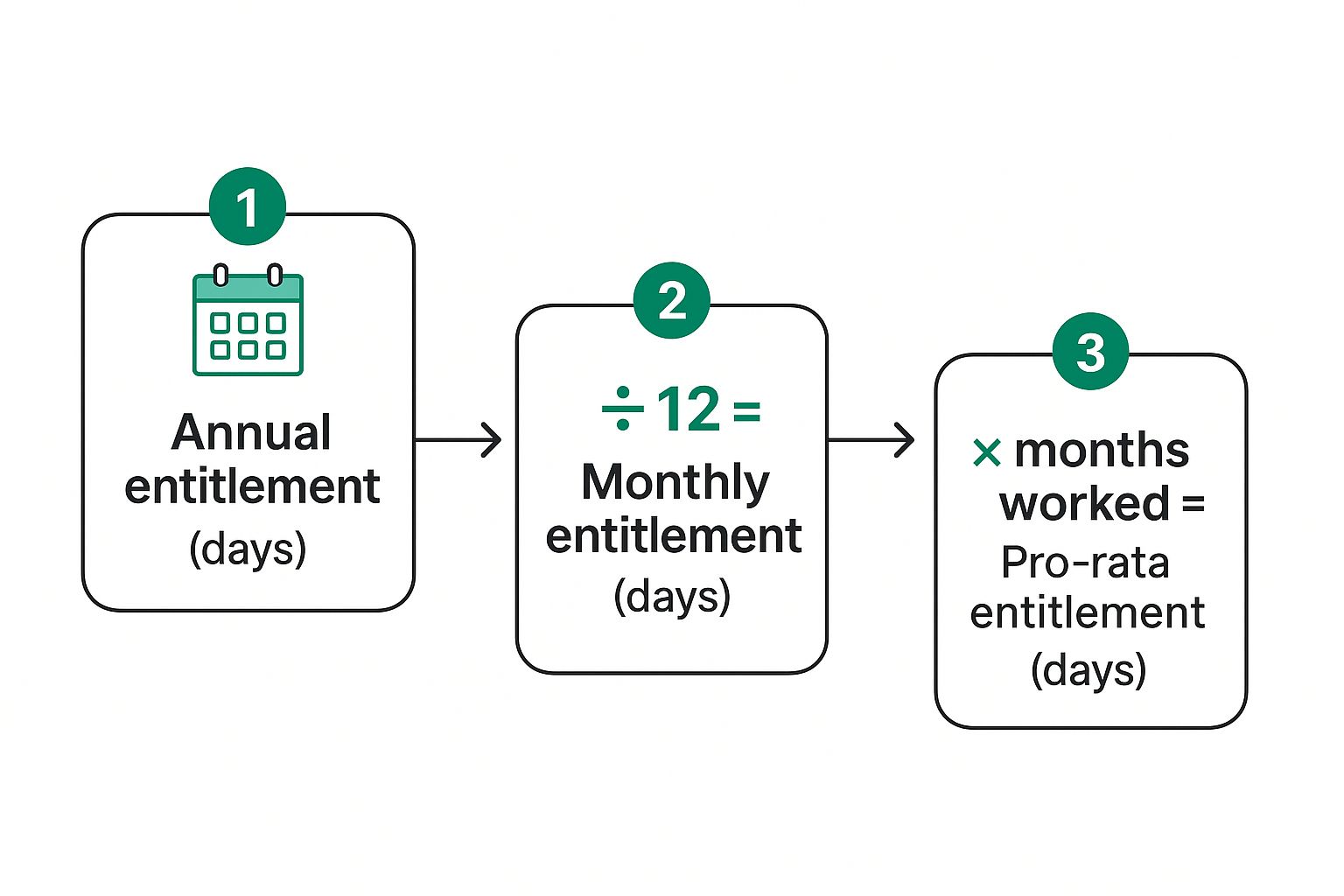
How Do You Work Out Your Holiday Entitlement in the UK?
Posted by Robin on 05 Oct, 2025 in
Figuring out holiday entitlement here in the UK really boils down to one simple rule: almost every single worker has a legal right to 5.6 weeks of paid holiday each year.
If you're working a standard five-day week, that translates into a nice, clean 28 days of annual leave. Simple as that.
Getting to Grips with Your Basic Holiday Rights

This right is the bedrock of every holiday calculation you'll ever do. As the official GOV.UK guidance makes clear, this isn't just for some people – it's for nearly everyone, even if you're an agency worker or on a zero-hours contract.
It’s a universal baseline that ensures we all get a fair amount of paid time off to recharge. But as soon as we mention those 28 days, the first question that always pops up is about bank holidays.
So, Are Bank Holidays Included in That?
This is a big one. Whether the eight annual bank holidays in England and Wales are part of your 28 days or are extra days off depends entirely on your employment contract. An employer can absolutely include them within that 5.6-week allowance, but they can also offer them on top.
Your contract of employment is the source of truth here. It should spell out:
- Whether you're expected to work on bank holidays.
- If those days are officially counted as part of your statutory 28-day entitlement.
- If you get them as additional paid days off, on top of the minimum.
If your contract doesn't mention it at all, the default assumption is that bank holidays are part of your 28 days. To see how this plays out in different situations, have a look at our ultimate guide to UK statutory holiday allowance.
To give you a clearer picture, here’s a quick-reference table showing the minimum entitlement for different work patterns.
UK Statutory Holiday Entitlement At a Glance
| Working Pattern | Minimum Statutory Weeks | Minimum Statutory Days (Including Bank Holidays) |
|---|---|---|
| 5 days a week | 5.6 weeks | 28 days |
| 4 days a week | 5.6 weeks | 22.4 days |
| 3 days a week | 5.6 weeks | 16.8 days |
| 2 days a week | 5.6 weeks | 11.2 days |
| 1 day a week | 5.6 weeks | 5.6 days |
As you can see, the 5.6 weeks is the constant – it's just the number of days that changes based on how often you work.
Legal Protection for Everyone
It's so important to remember that these rights aren't just for full-time, permanent staff. The law is designed to be fair across all kinds of working arrangements. That 5.6 weeks applies just as much to part-time, agency, and zero-hours workers.
This legal framework is all about preventing unfair treatment. A part-time employee, for instance, is entitled to the same holiday on a pro-rata basis as their full-time colleagues. They can't be penalised simply because they work fewer hours.
For businesses, getting this right is non-negotiable. Many find that specialised regulatory compliance training is essential to correctly apply these rules, protecting both the company and its people. Once you have this core legal foundation down, you can confidently move on to the specific calculations that match your own work pattern.
Calculating Holiday for Part-Time Workers

Just because someone works part-time doesn’t mean their holiday rights are any less important. The key principle here is that their entitlement is calculated on a pro-rata basis.
This is simply a fair way of saying their holiday is proportional to the hours a full-time employee works. It ensures everyone gets the same 5.6 weeks of statutory leave, but the final number of days (or hours) will naturally reflect their specific work pattern. It’s all about maintaining fairness and consistency across the team, regardless of contracted hours.
The Core Pro-Rata Formula
Figuring out the entitlement is often beautifully simple. The most common calculation just involves multiplying the statutory 5.6 weeks by the number of days the person works each week.
The formula is: 5.6 weeks × (Number of days you work per week) = Your annual leave in days.
Let's take a real-world example. Say you have a team member who works a consistent three days every week. Their calculation would look like this:
- 5.6 weeks × 3 days = 16.8 days of paid holiday per year.
You’ll often see employers round this figure up to the nearest half or full day to keep things tidy. In this case, their contract would likely state 17 days.
Key Takeaway: The pro-rata system isn't just good practice; it's a legal requirement designed to prevent part-time workers from being treated less favourably than their full-time colleagues. They are entitled to the exact same proportion of leave.
This basic calculation is the foundation for figuring out holiday entitlement when someone isn't on a standard full-time contract.
Scenarios Based on Hours Worked
But what if a schedule isn't based on set days, but on a specific number of hours per week? The principle is identical, but the calculation needs a slight tweak.
First, you need to know what a full-time week looks like at your company. Let's assume it's 37.5 hours over 5 days. A full-time employee's annual leave in hours would be:
- 5.6 weeks × 37.5 hours = 210 hours of holiday.
Now, let's say you have a part-timer who works 20 hours a week. To get their pro-rata entitlement, you can use this simple, two-step approach:
- Work out their hours as a percentage of a full week: (Your weekly hours ÷ Full-time weekly hours) × 100
- Apply that percentage to the full-time holiday allowance: That percentage × Full-time holiday hours = Your entitlement
Using our example: (20 ÷ 37.5) × 210 hours = 112 hours of holiday per year. This method ensures their leave is precisely matched to their actual working hours.
If you want an easy way to handle these calculations, our comprehensive holiday calculator for UK workers in our guide can manage both days and hours automatically, saving you the headache.
Handling Leave for Irregular Hours and Zero-Hours Contracts
Figuring out holiday entitlement for staff on irregular hours or zero-hours contracts used to be a real headache. Thankfully, recent changes have cleared things up, replacing guesswork with a straightforward, fair system. For anyone not on a fixed schedule, it all comes down to what they’ve actually worked.
Instead of a set number of days, their leave builds up as they go. The magic number you need to remember is 12.07%. This isn’t just pulled out of thin air; it’s a specific figure from UK employment law designed to keep things simple and proportional for workers on variable schedules.
This infographic breaks down the basic principle of pro-rata calculation, which is the same logic we apply here – entitlement is based on time worked.

The flow shows how an annual allowance is first broken down and then built back up based on the time an employee has been with the company. It’s a great visual for the core principle of proportional leave.
The Magic Number: 12.07 Percent Explained
So, where does this very specific percentage come from? It’s calculated directly from the statutory holiday allowance. A standard working year is 52 weeks, and every full-time worker gets 5.6 weeks of paid leave.
If you subtract the holiday weeks from the total, you get the number of weeks people are actually working:
- 52 weeks – 5.6 weeks = 46.4 working weeks
To work out the holiday entitlement as a percentage of time worked, you just divide the holiday weeks by the working weeks: (5.6 ÷ 46.4) × 100 = 12.07%.
This method has become the standard following recent legislative changes that simplified the whole process. By setting the statutory accrual rate at 12.07% of hours worked, the system is now far more consistent and easier for everyone to manage. You can read up on the full context of these holiday pay reforms to get a deeper understanding.
Putting the Calculation into Practice
Alright, let's get practical. How do you actually use this percentage to work out someone's holiday entitlement? All you need is the number of hours they’ve worked in a pay period.
The formula is beautifully simple:
Total hours worked × 0.1207 = Holiday hours accrued
Let's say a team member worked 80 hours last month. To find out how much paid holiday they’ve earned, you’d do this sum:
- 80 hours × 0.1207 = 9.656 hours
And there you have it. They’ve accrued just over nine and a half hours of paid leave to add to their total. You just need to run this simple calculation for each pay period.
Key Takeaway: This approach creates a direct and transparent link between hours worked and holiday earned. The more someone works, the more paid time off they get, which is exactly how it should be for flexible working arrangements.
What About Rolled-Up Holiday Pay?
You might come across the term ‘rolled-up’ holiday pay. This is an old practice where an employer adds a bit extra to someone's hourly rate—supposedly to cover their holiday pay—instead of paying them when they actually take the time off.
For instance, they might pay £10 per hour plus an extra £1.21 (12.07% of £10) and call that holiday pay. While it might sound convenient, this practice is not legally compliant for leave years starting on or after 1st April 2024. The law is clear: holiday pay must be paid when holiday is taken. This is to actively encourage people to actually take their well-earned breaks.
Managing Holiday Accrual When Starting or Leaving a Job

From the moment you walk through the door on your first day until your very last, your holiday entitlement is ticking away in the background. It’s not something you have to wait for or earn after a probation period; you start accruing paid leave from the second you’re on the payroll. Getting your head around this is crucial, especially when you're just starting out or getting ready to move on.
For the most part, employers keep things simple by using a monthly accrual system. The logic is sound: you earn your annual leave entitlement in twelve neat little chunks over the course of the year.
How Leave Builds Up Month by Month
The most common way to figure out your growing holiday pot is to divide your total annual allowance by twelve. This gives you the exact number of days you earn for each full month you're with the company.
- Annual Entitlement (in days) ÷ 12 = Days Accrued Per Month
So, for someone on the standard statutory minimum of 28 days, the maths looks like this: 28 ÷ 12 = 2.33 days per month.
Let's put that into a real-world scenario. Say you start a new job on 1st July. By the end of September, you’ve put in three solid months. Your accrued holiday would be:
- 2.33 days × 3 months = 6.99 days, which any reasonable employer will round up to a full 7 days.
This simple calculation gives everyone a clear, running total of the leave they're entitled to at any point, which helps avoid any nasty surprises.
Key Insight: The accrual system is all about fairness. It means that if you leave a job part-way through the year, you don’t lose out on the holiday you’ve rightfully earned. It’s a two-way street that protects both you and the business.
To make this crystal clear, here’s a quick table showing how that holiday allowance stacks up for a new starter with a 28-day entitlement.
Monthly Holiday Accrual Example (Based on 28 Days)
This table shows a cumulative breakdown of how many holiday days an employee accrues each month during their first year.
| Month of Employment | Days Accrued This Month | Total Days Accrued |
|---|---|---|
| Month 1 | 2.33 days | 2.33 days |
| Month 2 | 2.33 days | 4.66 days |
| Month 3 | 2.33 days | 6.99 days |
| Month 4 | 2.33 days | 9.32 days |
As you can see, the entitlement builds steadily month by month, giving you a clear picture of what you've earned.
Sorting Out Holiday When You Leave Your Job
The accrual system really comes into its own when you hand in your notice. Your final pay has to square everything up, including any holiday you’ve earned but haven't had a chance to take. The calculation is exactly the same—work out your pro-rata entitlement right up to your last day.
If you have unused days left in the bank, your employer has to pay you for them. This is often called a payment in lieu of holiday.
On the flip side, if you've been a bit keen and taken more holiday than you’ve actually accrued by your leaving date, your employer can usually deduct the difference from your final pay. This should always be clearly stated in your employment contract, so there are no shocks. For a really detailed look at this, it’s worth reading up on your specific holiday entitlement when leaving a job.
Untangling Common Scenarios and Holiday Headaches
Of course, life rarely sticks to a neat and tidy plan. Things like long-term illness or family leave can throw a spanner in the works, making holiday entitlement feel a bit more complicated. But don't worry, your right to paid time off is well-protected in these situations. It's just a case of knowing the rules.
When someone is off on long-term sick leave, or taking maternity, paternity, or adoption leave, their holiday entitlement keeps building up just as if they were in the office. This is a vital piece of legal protection. It means you're not penalised for taking essential time away for your health or your family.
What About Carrying Over Unused Days?
So, what happens if you get to the end of the leave year with a few days left in the bank? The rules around carrying leave over can be a bit of a grey area.
By law, you have to take at least four of your statutory weeks of leave within the year. But for that remaining 1.6 weeks (or any extra contractual leave your company offers), it’s up to your employer whether they let you carry it into the next year.
The company's own policy is king here. Your employee handbook or contract should spell out:
- Exactly how many days you're allowed to carry over.
- The deadline for using up any leave you've brought forward.
It's worth remembering that your right to carry over all 5.6 weeks of statutory leave is protected if you couldn't take it because you were on sick, maternity, or other family-related leave. This ensures you never lose out on holiday due to circumstances you can't control.
The Culture Around Taking Time Off
Knowing your legal rights is one thing, but the culture in your workplace can make a huge difference in whether you feel you can actually use all your holiday. A high-pressure environment can easily lead to 'leaveism' – where people feel guilty or unable to fully switch off.
Recent trends are a little worrying on this front. Research has shown a drop in the average annual leave people are taking, falling by around 7.67% from 2022 to 2023. That’s part of a bigger slide of almost 12% since 2020, as laid out in a fascinating UK annual leave report.
This data really underlines why it’s so important to not only track leave accurately but also to build a culture where taking a proper break is encouraged. It’s the only way to prevent burnout and keep a healthy work-life balance for the whole team.
Your Holiday Entitlement Questions Answered
Knowing the formulas for calculating holiday is a great start, but real life rarely fits into a neat little box. Things get complicated. We get a lot of questions about the tricky, specific situations that pop up, so let's run through some of the most common ones.
Can My Boss Tell Me When to Take My Holiday?
In short, yes. It might not feel right, but your employer can absolutely tell you when to take some (or all) of your annual leave.
This often happens for company-wide shutdowns, like over the Christmas break, or just to make sure the business has enough people on deck during its busiest spells.
For this to be above board, your boss has to give you proper warning. The golden rule is that they must provide at least double the length of notice for the holiday they want you to take. So, if they need you to take five days off, they have to let you know at least ten days before it starts.
What if a Bank Holiday Falls on My Day Off?
This is a classic point of confusion, and it trips up part-time workers all the time. If a bank holiday lands on a day you wouldn't normally be working, your employer isn't legally required to give you another day off instead.
But this is where that pro-rata entitlement we talked about becomes so important. Part-time staff are entitled to the same holiday as their full-time colleagues, just scaled down. To keep things fair, most sensible employers will work out a part-timer’s pro-rata bank holiday allowance and simply add it to their total leave, letting them use it whenever they like.
Key Takeaway: Your contract of employment is your best friend here. It should spell out exactly how bank holidays are handled for everyone, ensuring that part-time employees aren't getting a raw deal over the course of the year.
How Much Notice Do I Need to Give for a Holiday Request?
It’s a two-way street. Just like your employer has to give you notice, you have to give them a heads-up before you jet off.
The statutory minimum notice you have to give is twice as long as the amount of leave you want to take. Planning a two-week getaway? You need to get that request in at least four weeks in advance.
Of course, your company will likely have its own policy on this, which might ask for even more notice, so always check your employee handbook or company intranet first.
Can I Be Paid Instead of Taking My Holiday?
The simple answer is no, not usually. That statutory 5.6 weeks of annual leave is a legal requirement designed to make sure you get proper rest and avoid burnout. You can’t just trade it for cash.
The only time you can be paid for statutory leave you haven't taken is when you leave your job. At that point, any accrued but unused holiday will be paid out in your final salary.
Trying to keep track of all these rules, requests, and calculations with a spreadsheet is a recipe for disaster.
With Leavetrack, you can put it all on autopilot. It handles the accruals, gives you a central place for all requests, and shows you the entire team's schedule in one clear planner. Stop wasting time with clunky spreadsheets and make sure your team's leave is managed fairly and legally. Find out more at https://leavetrackapp.com.
